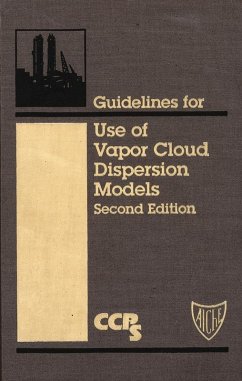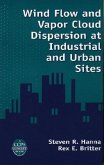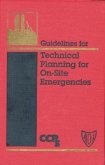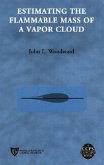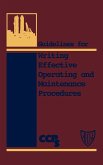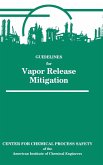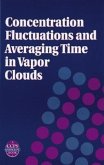Ccps (Center For Chemical Process Safety)
Guidelines for Use of Vapor Cloud Dispersion Models
Ccps (Center For Chemical Process Safety)
Guidelines for Use of Vapor Cloud Dispersion Models
- Broschiertes Buch
Andere Kunden interessierten sich auch für
![Wind Flow and Vapor Cloud Dispersion at Industrial and Urban Sites Wind Flow and Vapor Cloud Dispersion at Industrial and Urban Sites]() Steven R HannaWind Flow and Vapor Cloud Dispersion at Industrial and Urban Sites246,99 €
Steven R HannaWind Flow and Vapor Cloud Dispersion at Industrial and Urban Sites246,99 €![Guidelines for Technical Planning for On-Site Emergencies Guidelines for Technical Planning for On-Site Emergencies]() Ccps (Center For Chemical Process Safety)Guidelines for Technical Planning for On-Site Emergencies248,99 €
Ccps (Center For Chemical Process Safety)Guidelines for Technical Planning for On-Site Emergencies248,99 €![Estimating the Flammable Mass of a Vapor Cloud Estimating the Flammable Mass of a Vapor Cloud]() John L WoodwardEstimating the Flammable Mass of a Vapor Cloud248,99 €
John L WoodwardEstimating the Flammable Mass of a Vapor Cloud248,99 €![Guidelines for Writing Effective Operating and Maintenance Procedures Guidelines for Writing Effective Operating and Maintenance Procedures]() Center for Chemical Process Safety (CCPS)Guidelines for Writing Effective Operating and Maintenance Procedures191,99 €
Center for Chemical Process Safety (CCPS)Guidelines for Writing Effective Operating and Maintenance Procedures191,99 €![Guidelines for Vapor Release Mitigation Guidelines for Vapor Release Mitigation]() Richard W PrughGuidelines for Vapor Release Mitigation129,99 €
Richard W PrughGuidelines for Vapor Release Mitigation129,99 €![Concentration Fluctuations and Averaging Time in Vapor Clouds Concentration Fluctuations and Averaging Time in Vapor Clouds]() David J WilsonConcentration Fluctuations and Averaging Time in Vapor Clouds182,99 €
David J WilsonConcentration Fluctuations and Averaging Time in Vapor Clouds182,99 €![Guidelines for Implementing Process Safety Management Guidelines for Implementing Process Safety Management]() Center for Chemical Process Safety (CCPS)Guidelines for Implementing Process Safety Management143,99 €
Center for Chemical Process Safety (CCPS)Guidelines for Implementing Process Safety Management143,99 €-
-
-
Produktdetails
- Verlag: Wiley
- 2nd edition
- Seitenzahl: 304
- Erscheinungstermin: 15. Dezember 1996
- Englisch
- Abmessung: 233mm x 160mm x 21mm
- Gewicht: 585g
- ISBN-13: 9780816907021
- ISBN-10: 0816907021
- Artikelnr.: 23238041
Hinweis: Dieser Artikel kann nur an eine deutsche Lieferadresse ausgeliefert werden.
- Herstellerkennzeichnung
- Libri GmbH
- Europaallee 1
- 36244 Bad Hersfeld
- gpsr@libri.de
The CENTER FOR CHEMICAL PROCESS SAFETY (CCPS), an industry technology alliance of the American Institute of Chemical Engineers (AIChE), has been a world leader in developing and disseminatinginformation on process safety management and technology since 1985. CCPS has published over 80 books in its process safety guidelines and process safety concepts series. For more information, visit www.ccpsonline.org.
Preface.
Acknowledgments.
Nomenclature.
1. Background and Objectives.
2. Overview of Modeling Procedures, Including Rationale for Selecting
Scenarios for Worked Examples.
2.1 Types of Scenarios and Models.
2.2 Gross Screening Analysis.
2.3 Scenarios Selected for Worked Examples.
3. Input Data Required.
3.1 Source data.
3.2 Site Characteristics.
3.3 Meteorological Data and Formulas for Calculating Input Parameters.
3.4 Receptor Related Data.
4. Source Emission Models.
4.1 Conceptual Process for Source Term Determination.
4.2 Calculation of Source Terms.
4.2.1 Gas Jet Releases.
4.2.2 Liquid Jet Releases.
4.2.3 Two-Phase Jet Releases.
4.2.4 Liquid Pool Spreading.
4.2.5 Liquid Pool Evaporation.
4.3 Uncertainties in Source Term Estimation.
5. Dispersion Models.
5.1 Critical Richardson Number Criterion.
5.2 Jet Trajectory and Entrainment.
5.2.1 Momentum-Dominated Jets.
5.2.2 Elevated Dense Gas Jets.
5.2.3 Positively Buoyant Plumes.
5.3 Dense Gas Release at grade.
5.3.1 Background and Overview.
5.3.2 Dense Gas Clouds in the Absence of Heat Exchange.
5.3.3 Dense Gas Clouds in the Presence of Heat Exchanges.
5.4 Transport and Dispersion of Neutrally Buoyant of Passive Gas Clouds.
5.5 Simple Nomograms for Calculating the Dilution of Dense Gas Release.
5.6 Three-Dimensional Numerical Models of Dense Gas Dispersion.
5.7 Transport and Dispersion Near Buildings.
5.7.1 Plume Confinement by Canyons.
5.7.2 Concentrations on Building Faces Due to Releases from Vents.
5.7.3 Concentrations on the Building Downwind Face (the Near-Wake) Due to
Releases from Sources on the Building.
5.7.4 Other Effects of Buildings.
5.8 Worst Case Meteorological Conditions.
5.9 Removal by Dry and Wet Deposition.
5.9.1 Gravitational Settling of Large Particles of Aerosols.
5.9.2 Dry Deposition of Small particles and Gases.
5.9.3 Removal of Particles and Gases by Participation and Clouds (Wet
Deposition).
6. Averaging Times, Concentration Fluctuations, and Modeling Uncertainties.
6.1 Overview of Physical Considerations Related to Averaging Time.
6.2 Overview of Characteristics of Concentration Fluctuations in Plumes.
6.3 Predictions of Concentrations on the Plume Centerline at a Given
Downwind Distance as a Function of Averaging Time, Ta.
6.4 Predictions of Concentrations at a Given Receptor Position as a
Function of Averaging Time, Ta.
6.5 Threshold Crossing Probability.
6.6 A general Structure for the Analysis of Model Uncertainties.
7. Overview of Operational Vapor Cloud Models in Common Use.
7.1 Summary of Commonly used Models.
7.2 Characteristics of Commonly Used Vapor Cloud Dispersion Models.
8. Evaluation of Models with Field Data.
8.1 Description of Field Data Sets.
8.2 Model Evaluation Procedures.
8.3 Models Evaluated.
8.4 Results of Model Evaluations.
9. Summary of Seven Worked Examples.
9.1 Description of Seven Scenarios Used for Worked Examples.
9.2 Overview of Predicted Concentrations.
Appendix A. Scenario 1: Release of Pressurized Liquid Chlorine.
Appendix B. Scenario 2: Liquid (Cryogenic) Spill of Refrigerated Chlorine.
Appendix C. Scenario 3: Liquid (Noncryogenic) Spill of Liquid Acetone.
Appendix D. Scenario 4: Vertical Jet Release of a Dense Gas (Normal
Butane).
Appendix E. Scenario 5: Release of SO3 within a Building and Subsequent
Dispersion of H2SO4 from a Vent on the Building.
Appendix F. Scenario 6: Pressurized Horizontal Gas Jet Release of a
Multicomponent Mixture.
Appendix G. Scenario 7: Transient (Mitigated) Area-Source Release of
Hydrogen Fluoride.
References.
Index.
Acknowledgments.
Nomenclature.
1. Background and Objectives.
2. Overview of Modeling Procedures, Including Rationale for Selecting
Scenarios for Worked Examples.
2.1 Types of Scenarios and Models.
2.2 Gross Screening Analysis.
2.3 Scenarios Selected for Worked Examples.
3. Input Data Required.
3.1 Source data.
3.2 Site Characteristics.
3.3 Meteorological Data and Formulas for Calculating Input Parameters.
3.4 Receptor Related Data.
4. Source Emission Models.
4.1 Conceptual Process for Source Term Determination.
4.2 Calculation of Source Terms.
4.2.1 Gas Jet Releases.
4.2.2 Liquid Jet Releases.
4.2.3 Two-Phase Jet Releases.
4.2.4 Liquid Pool Spreading.
4.2.5 Liquid Pool Evaporation.
4.3 Uncertainties in Source Term Estimation.
5. Dispersion Models.
5.1 Critical Richardson Number Criterion.
5.2 Jet Trajectory and Entrainment.
5.2.1 Momentum-Dominated Jets.
5.2.2 Elevated Dense Gas Jets.
5.2.3 Positively Buoyant Plumes.
5.3 Dense Gas Release at grade.
5.3.1 Background and Overview.
5.3.2 Dense Gas Clouds in the Absence of Heat Exchange.
5.3.3 Dense Gas Clouds in the Presence of Heat Exchanges.
5.4 Transport and Dispersion of Neutrally Buoyant of Passive Gas Clouds.
5.5 Simple Nomograms for Calculating the Dilution of Dense Gas Release.
5.6 Three-Dimensional Numerical Models of Dense Gas Dispersion.
5.7 Transport and Dispersion Near Buildings.
5.7.1 Plume Confinement by Canyons.
5.7.2 Concentrations on Building Faces Due to Releases from Vents.
5.7.3 Concentrations on the Building Downwind Face (the Near-Wake) Due to
Releases from Sources on the Building.
5.7.4 Other Effects of Buildings.
5.8 Worst Case Meteorological Conditions.
5.9 Removal by Dry and Wet Deposition.
5.9.1 Gravitational Settling of Large Particles of Aerosols.
5.9.2 Dry Deposition of Small particles and Gases.
5.9.3 Removal of Particles and Gases by Participation and Clouds (Wet
Deposition).
6. Averaging Times, Concentration Fluctuations, and Modeling Uncertainties.
6.1 Overview of Physical Considerations Related to Averaging Time.
6.2 Overview of Characteristics of Concentration Fluctuations in Plumes.
6.3 Predictions of Concentrations on the Plume Centerline at a Given
Downwind Distance as a Function of Averaging Time, Ta.
6.4 Predictions of Concentrations at a Given Receptor Position as a
Function of Averaging Time, Ta.
6.5 Threshold Crossing Probability.
6.6 A general Structure for the Analysis of Model Uncertainties.
7. Overview of Operational Vapor Cloud Models in Common Use.
7.1 Summary of Commonly used Models.
7.2 Characteristics of Commonly Used Vapor Cloud Dispersion Models.
8. Evaluation of Models with Field Data.
8.1 Description of Field Data Sets.
8.2 Model Evaluation Procedures.
8.3 Models Evaluated.
8.4 Results of Model Evaluations.
9. Summary of Seven Worked Examples.
9.1 Description of Seven Scenarios Used for Worked Examples.
9.2 Overview of Predicted Concentrations.
Appendix A. Scenario 1: Release of Pressurized Liquid Chlorine.
Appendix B. Scenario 2: Liquid (Cryogenic) Spill of Refrigerated Chlorine.
Appendix C. Scenario 3: Liquid (Noncryogenic) Spill of Liquid Acetone.
Appendix D. Scenario 4: Vertical Jet Release of a Dense Gas (Normal
Butane).
Appendix E. Scenario 5: Release of SO3 within a Building and Subsequent
Dispersion of H2SO4 from a Vent on the Building.
Appendix F. Scenario 6: Pressurized Horizontal Gas Jet Release of a
Multicomponent Mixture.
Appendix G. Scenario 7: Transient (Mitigated) Area-Source Release of
Hydrogen Fluoride.
References.
Index.
Preface.
Acknowledgments.
Nomenclature.
1. Background and Objectives.
2. Overview of Modeling Procedures, Including Rationale for Selecting
Scenarios for Worked Examples.
2.1 Types of Scenarios and Models.
2.2 Gross Screening Analysis.
2.3 Scenarios Selected for Worked Examples.
3. Input Data Required.
3.1 Source data.
3.2 Site Characteristics.
3.3 Meteorological Data and Formulas for Calculating Input Parameters.
3.4 Receptor Related Data.
4. Source Emission Models.
4.1 Conceptual Process for Source Term Determination.
4.2 Calculation of Source Terms.
4.2.1 Gas Jet Releases.
4.2.2 Liquid Jet Releases.
4.2.3 Two-Phase Jet Releases.
4.2.4 Liquid Pool Spreading.
4.2.5 Liquid Pool Evaporation.
4.3 Uncertainties in Source Term Estimation.
5. Dispersion Models.
5.1 Critical Richardson Number Criterion.
5.2 Jet Trajectory and Entrainment.
5.2.1 Momentum-Dominated Jets.
5.2.2 Elevated Dense Gas Jets.
5.2.3 Positively Buoyant Plumes.
5.3 Dense Gas Release at grade.
5.3.1 Background and Overview.
5.3.2 Dense Gas Clouds in the Absence of Heat Exchange.
5.3.3 Dense Gas Clouds in the Presence of Heat Exchanges.
5.4 Transport and Dispersion of Neutrally Buoyant of Passive Gas Clouds.
5.5 Simple Nomograms for Calculating the Dilution of Dense Gas Release.
5.6 Three-Dimensional Numerical Models of Dense Gas Dispersion.
5.7 Transport and Dispersion Near Buildings.
5.7.1 Plume Confinement by Canyons.
5.7.2 Concentrations on Building Faces Due to Releases from Vents.
5.7.3 Concentrations on the Building Downwind Face (the Near-Wake) Due to
Releases from Sources on the Building.
5.7.4 Other Effects of Buildings.
5.8 Worst Case Meteorological Conditions.
5.9 Removal by Dry and Wet Deposition.
5.9.1 Gravitational Settling of Large Particles of Aerosols.
5.9.2 Dry Deposition of Small particles and Gases.
5.9.3 Removal of Particles and Gases by Participation and Clouds (Wet
Deposition).
6. Averaging Times, Concentration Fluctuations, and Modeling Uncertainties.
6.1 Overview of Physical Considerations Related to Averaging Time.
6.2 Overview of Characteristics of Concentration Fluctuations in Plumes.
6.3 Predictions of Concentrations on the Plume Centerline at a Given
Downwind Distance as a Function of Averaging Time, Ta.
6.4 Predictions of Concentrations at a Given Receptor Position as a
Function of Averaging Time, Ta.
6.5 Threshold Crossing Probability.
6.6 A general Structure for the Analysis of Model Uncertainties.
7. Overview of Operational Vapor Cloud Models in Common Use.
7.1 Summary of Commonly used Models.
7.2 Characteristics of Commonly Used Vapor Cloud Dispersion Models.
8. Evaluation of Models with Field Data.
8.1 Description of Field Data Sets.
8.2 Model Evaluation Procedures.
8.3 Models Evaluated.
8.4 Results of Model Evaluations.
9. Summary of Seven Worked Examples.
9.1 Description of Seven Scenarios Used for Worked Examples.
9.2 Overview of Predicted Concentrations.
Appendix A. Scenario 1: Release of Pressurized Liquid Chlorine.
Appendix B. Scenario 2: Liquid (Cryogenic) Spill of Refrigerated Chlorine.
Appendix C. Scenario 3: Liquid (Noncryogenic) Spill of Liquid Acetone.
Appendix D. Scenario 4: Vertical Jet Release of a Dense Gas (Normal
Butane).
Appendix E. Scenario 5: Release of SO3 within a Building and Subsequent
Dispersion of H2SO4 from a Vent on the Building.
Appendix F. Scenario 6: Pressurized Horizontal Gas Jet Release of a
Multicomponent Mixture.
Appendix G. Scenario 7: Transient (Mitigated) Area-Source Release of
Hydrogen Fluoride.
References.
Index.
Acknowledgments.
Nomenclature.
1. Background and Objectives.
2. Overview of Modeling Procedures, Including Rationale for Selecting
Scenarios for Worked Examples.
2.1 Types of Scenarios and Models.
2.2 Gross Screening Analysis.
2.3 Scenarios Selected for Worked Examples.
3. Input Data Required.
3.1 Source data.
3.2 Site Characteristics.
3.3 Meteorological Data and Formulas for Calculating Input Parameters.
3.4 Receptor Related Data.
4. Source Emission Models.
4.1 Conceptual Process for Source Term Determination.
4.2 Calculation of Source Terms.
4.2.1 Gas Jet Releases.
4.2.2 Liquid Jet Releases.
4.2.3 Two-Phase Jet Releases.
4.2.4 Liquid Pool Spreading.
4.2.5 Liquid Pool Evaporation.
4.3 Uncertainties in Source Term Estimation.
5. Dispersion Models.
5.1 Critical Richardson Number Criterion.
5.2 Jet Trajectory and Entrainment.
5.2.1 Momentum-Dominated Jets.
5.2.2 Elevated Dense Gas Jets.
5.2.3 Positively Buoyant Plumes.
5.3 Dense Gas Release at grade.
5.3.1 Background and Overview.
5.3.2 Dense Gas Clouds in the Absence of Heat Exchange.
5.3.3 Dense Gas Clouds in the Presence of Heat Exchanges.
5.4 Transport and Dispersion of Neutrally Buoyant of Passive Gas Clouds.
5.5 Simple Nomograms for Calculating the Dilution of Dense Gas Release.
5.6 Three-Dimensional Numerical Models of Dense Gas Dispersion.
5.7 Transport and Dispersion Near Buildings.
5.7.1 Plume Confinement by Canyons.
5.7.2 Concentrations on Building Faces Due to Releases from Vents.
5.7.3 Concentrations on the Building Downwind Face (the Near-Wake) Due to
Releases from Sources on the Building.
5.7.4 Other Effects of Buildings.
5.8 Worst Case Meteorological Conditions.
5.9 Removal by Dry and Wet Deposition.
5.9.1 Gravitational Settling of Large Particles of Aerosols.
5.9.2 Dry Deposition of Small particles and Gases.
5.9.3 Removal of Particles and Gases by Participation and Clouds (Wet
Deposition).
6. Averaging Times, Concentration Fluctuations, and Modeling Uncertainties.
6.1 Overview of Physical Considerations Related to Averaging Time.
6.2 Overview of Characteristics of Concentration Fluctuations in Plumes.
6.3 Predictions of Concentrations on the Plume Centerline at a Given
Downwind Distance as a Function of Averaging Time, Ta.
6.4 Predictions of Concentrations at a Given Receptor Position as a
Function of Averaging Time, Ta.
6.5 Threshold Crossing Probability.
6.6 A general Structure for the Analysis of Model Uncertainties.
7. Overview of Operational Vapor Cloud Models in Common Use.
7.1 Summary of Commonly used Models.
7.2 Characteristics of Commonly Used Vapor Cloud Dispersion Models.
8. Evaluation of Models with Field Data.
8.1 Description of Field Data Sets.
8.2 Model Evaluation Procedures.
8.3 Models Evaluated.
8.4 Results of Model Evaluations.
9. Summary of Seven Worked Examples.
9.1 Description of Seven Scenarios Used for Worked Examples.
9.2 Overview of Predicted Concentrations.
Appendix A. Scenario 1: Release of Pressurized Liquid Chlorine.
Appendix B. Scenario 2: Liquid (Cryogenic) Spill of Refrigerated Chlorine.
Appendix C. Scenario 3: Liquid (Noncryogenic) Spill of Liquid Acetone.
Appendix D. Scenario 4: Vertical Jet Release of a Dense Gas (Normal
Butane).
Appendix E. Scenario 5: Release of SO3 within a Building and Subsequent
Dispersion of H2SO4 from a Vent on the Building.
Appendix F. Scenario 6: Pressurized Horizontal Gas Jet Release of a
Multicomponent Mixture.
Appendix G. Scenario 7: Transient (Mitigated) Area-Source Release of
Hydrogen Fluoride.
References.
Index.

